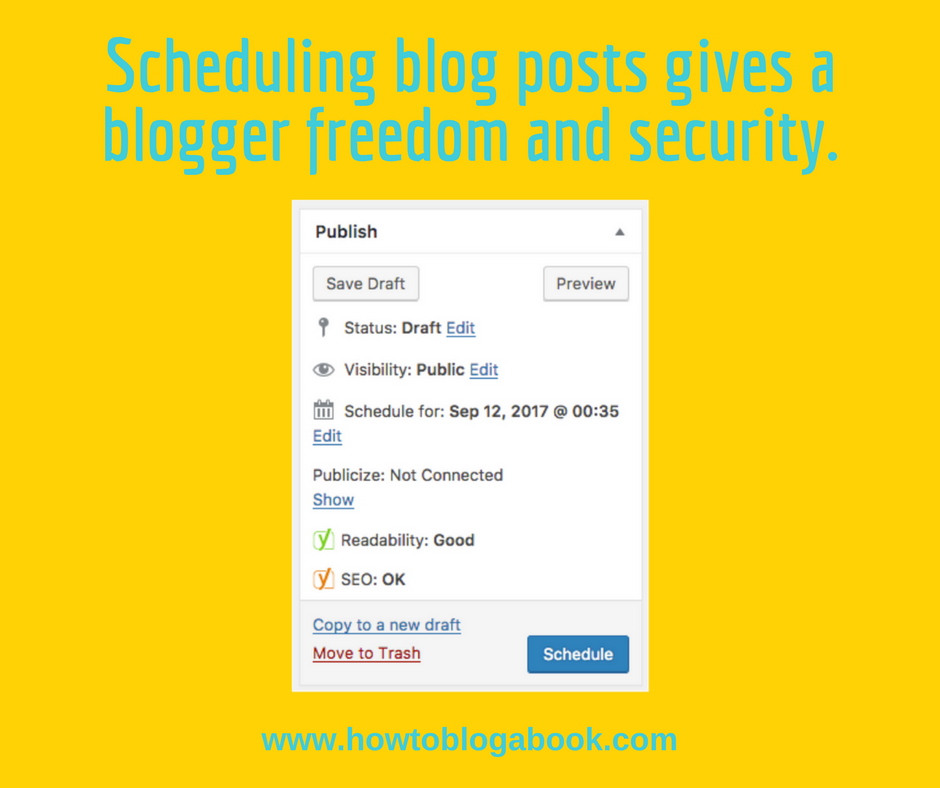Have you taken a “rainy-day” approach to your blog? In other words, you have saved or scheduled blog posts for the future—just in case. In today’s guest post, freelance writer and ghostwriter Dan Kenitz (@buildwithwords) explains the advantages of using the schedule feature of your blog strategically.
“It wasn’t raining when Noah built the ark.”
~Howard Ruff
Howard Ruff was a financial advisor. But that doesn’t mean the phrase “rainy day” has to apply only to the emergency savings account you have in the bank. It should also apply to your blog. For the sake of your blog’s quality—and your sanity—try to start scheduling your blog posts at least a month in advance.
Why You Need to Schedule Your Blog So Far Ahead
I know what you’re thinking. “If I schedule blog posts in advance, I can’t respond to trends and news.” Not so. Think of scheduling your blog in advance as a sort of “emergency fund” of content. You don’t have to publish those timeless posts you have stashed away.
When you do it right, scheduling your blog posts far in advance will yield far more benefits than drawbacks, including:
- Vacation time. Setting your blog automatically to post a few ditties while you’re away is a sure way to keep the audience satisfied and the site active—even while you’re on the beach sipping Mai Tais.
- Cushion time. Just as an emergency fund is a financial cushion, working ahead with your blog posts will give you cushion time should an unforeseen limitation head your way. You built a blog for more freedom, after all. If you don’t have posts scheduled in advance, you remain indentured to the daily grind.
- Editing and proofreading. If you’re one of those “straight from the fingers and onto the Web” bloggers, that’s fine. But stashing an article or two away can give you ample time to review and read over these posts, improving their quality—think of it like aging cheeses to give them their proper flavor.
True: if you schedule your posts at least a month in advance, you’ll have to rely on more timeless posts. But nothing stops you from inserting a timely blog update along the way, either.
How to Schedule Blog Posts Properly
As long as you’re using a content management system like WordPress, scheduling your posts in advance is easy. Simply select the dates you want your articles to go live, and set them to publish accordingly. (Learn more about how to schedule posts here.)
Chances are, by now you’ve got some sense of rhythm as to how many posts you need to release on a regular basis. With the “one month rule,” you should aim to work ahead until you have enough posts to handle that workload for four full weeks.
You don’t have to do this all at once. In fact, it’s better that you don’t rush it. Make a habit of contributing to a new post every time you finish a fresh one. Even setting aside just ten minutes a day to work on future posts will eventually yield you a treasure trove of content waiting to be published.
Seriously, just ten minutes. Go to e.ggtimer.com/10minutes after you work on your blog and put a little “deposit” down on your blog’s future.
In the end, your blog will be better for it.
Do you schedule blog posts in advance? Tell me how that works for you in a comment below.
About the Author
 Dan Kenitz is a freelance writer and ghostwriter from Wisconsin who helps individuals and companies build their brands through valuable content. www.empirewriter.com/
Dan Kenitz is a freelance writer and ghostwriter from Wisconsin who helps individuals and companies build their brands through valuable content. www.empirewriter.com/


I used to schedule posts a month in advance, but got out of the habit. I’m now working to get back into that habit, because my days and weeks are a lot less stressful when I know all I have to do today is share the post that’s just gone live … not write, edit, and load it by posting time.
Planning in advance also means I don’t get caught out by guest posts, which is good for both me and my hosts.
I, too, am working to get a month in advance…or at least a few weeks. This allows me to travel or attend events without stress. It take upront work, though, doesn’t it?